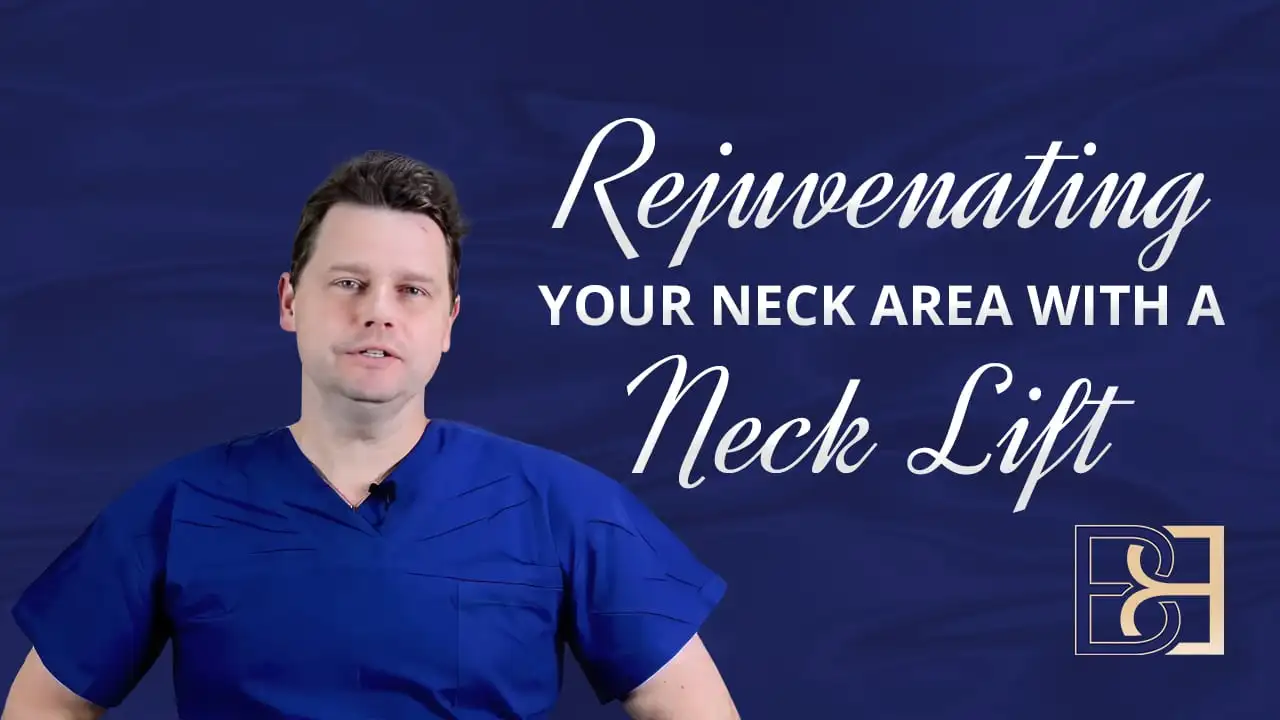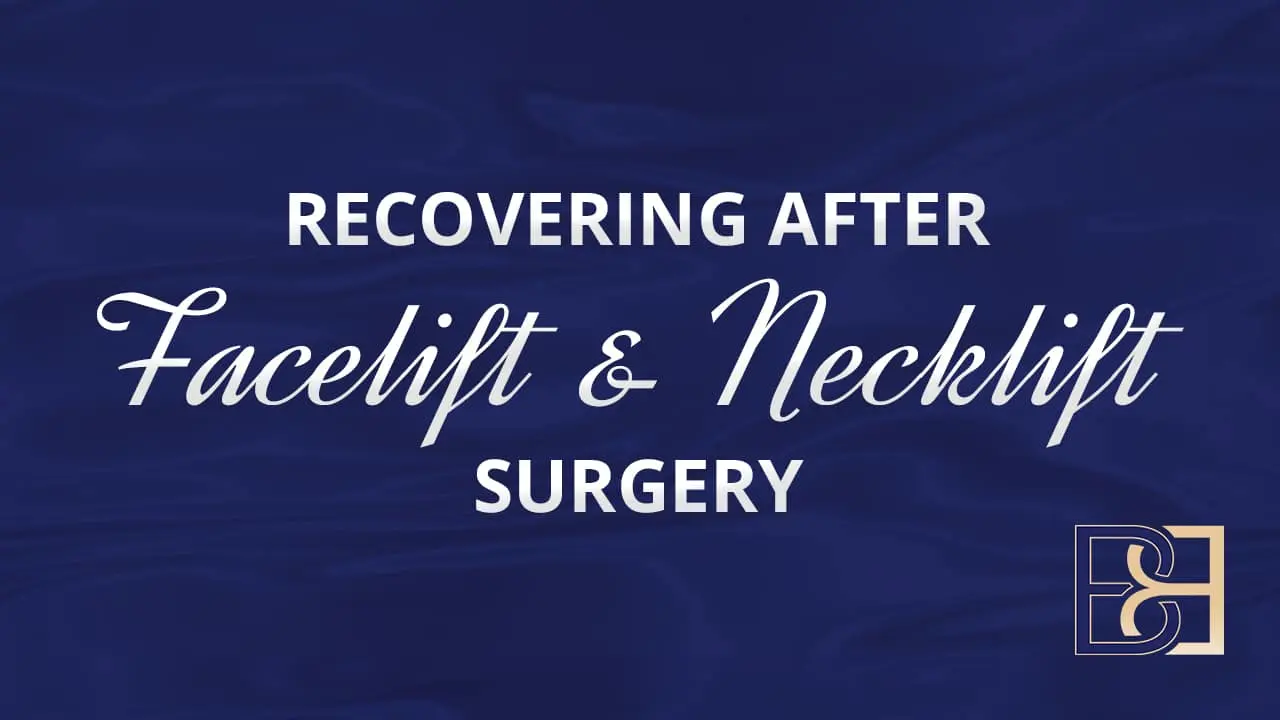What are they? Facelifts have changed dramatically in the last 30 years. Current techniques have ** upon the results of older techniques, often with less scarring and ** healing. The wind swept, “tight” look of the 1970s is usually avoidable with modern facelift techniques performed by a skilled surgeon.
The modern face lift elevates the muscles and fascia under the skin and only removes excess skin. The skin itself is not tightened or pulled. This approach produces a more **, in addition to providing a finer scar in many cases, so long as it is performed correctly and the patient doesn’t have a history of poor scarring.
A facelift (also called a rhytidectomy) is not a single or standard operation. Tailored to each individual, the procedure can range from a small mini-lift to traditional full facelift, and may include a number of other procedures to ** the final result. The operation elevates and re-drapes the facial skin and underlying musculature to eliminate laxity and **. It can also be designed to correct problems in the neck, under the jaw and/or chin and in the cheeks. A mid-face lift is so called because it ** ** in the cheek area or middle-third of the face. This procedure is popular with ** facelift patients, whereas older patients tend to require a full facelift to ** ageing in the lower two thirds of the face and neck.
A facelift can:
- Elevate the facial tissues to ** ** and changes in face shape
- Tighten skin to remove wrinkles.
- ** jowls and neck bands
There are many different names and variations of facelifts that you may have researched online.
Some of these names are:
- Skin only facelift (also referred to as cutaneous lift)
- S – lift
- MACS lift (Minimal Access Cranial Suspension lift)
- Mini-facelift
- Composite facelift
- Extended full facelift
- Full facelift
- Deep plane facelift
- Sub-SMAS facelift
- Two layer facelift
- Limited lift with SMAS manipulation
- Rhytidectomy
- Short scar facelift
- Baker flap facelift
- Endoscopic facelift
- Midface lift
- Cheek Lift
- Thread lift
- Necklift
- Liquid facelift
- Traditional face lift
- Coronal lift
- Subperiosteal Lift
- Temporal Facelift
- Platysmaplasty
- Submentoplasty
- Feather lift
- Non-surgical facelift
If you are a patient researching which surgeon to see and what operation you think that you need, then it can be quite hard to figure this out when reading different websites. The terminology is confusing, and not all surgeons use the same terminology to describe the same operation. For example one surgeon may refer to a “mini” facelift as a skin only facelift, another may use this term for a SMAS plication facelift. Even when talking about a similar facelift, such as the skin only facelift, there can be wide variations as to what is actually done. A skin only facelift, can be a facelift with no undermining of the skin (sometimes referred to as a S-lift), as well as one with wide undermining of the skin. So you may be talking about a facelift that takes one hour versus one that takes four hours, with vastly different results and recovery.
To be able to understand what facelift you are actually getting, it is important to look at what is done during the facelift, and not what the name of the facelift is. To be able to describe all the different facelifts in more detail, we need to first understand the SMAS (superficial musculo aponeurotic system), as this fascia is a critical structure in facelift surgery and determines what result you can expect and the recovery that you can expect.
Book your appointment online now
Anatomy of a facelift
To understand what a facelift does and is, it is necessary to understand the anatomy of the face. I will try to make this as clear as possible, mainly so that you can understand what we are trying to accomplish with a facelift.

The SMAS (superficial musculo-aponeurotic system)
This is a strong layer of tissue that sits just above the muscles of facial movement (Ref 6). It becomes the platysma muscle in the neck, and it blends into the fascia of the temporalis muscle. It contains all the fat pads of the face. When we age the fat pads in the cheeks fall down (creating a prominent tear trough). In the jaw the jowls are created, and towards the middle of the face you get more prominent nasolabial folds and marionette lines due to the descent of this structure.
Skoog (Ref 8) was a Swedish plastic surgeon that first described going deep to this structure to create a facelift that was more long lasting. As with many things in medicine, it took a long time for other plastic surgeons to accept these techniques, and it was not until after his death, that the SMAS facelift became more popular.
Why is the SMAS so important in a facelift?
Skin is elastic and any facelift that removes skin only tends to not last as long. This has been proven with research (Ref 4). The early result from both deeper facelifts and more superficial facelifts tend to be very similar. However, the skin only facelifts tend to ** much ** after the original operation. Trying to pull on the skin to make the facelift last longer just ends up with ** results.
The SMAS is a relatively inelastic layer in the face, and if this is lifted and repositioned then the results last longer.
The other big factor is that all the important nerves run underneath the SMAS, such as the facial nerve that controls the movement of your facial muscles. Staying above the SMAS is potentially safer, as there are no nerves here (other than sensory nerves). The reason why the parotid gland is so important in the face, is that the facial nerve runs inside this gland. So when performing a SMAS facelift you start dissecting on top of the gland, which is potentially safer, although once you get to the end of the gland the nerves emerge, and care has to be taken not to injure these.
Going deeper to the SMAS and trying to lift and stitch the deeper structures is called a deep plane facelift. Some research has shown that there is no benefit in doing this either for the longevity of the result or the actual result (Ref 1). The risks and complications however are much higher with this type of facelift, as is the recovery from the surgery.
How to make sense of the different facelift techniques
To make sense of all the different names and techniques is to think about how they relate to the SMAS. If the technique is working on the tissues superficial to the SMAS, then it is a superficial facelift. If it is working on the SMAS, then it is a SMAS lift. If it is working on the tissues under the SMAS, then it is a deep plane facelift. Additionally, a neck lift is all about tightening the platysma muscle in the neck, and is therefore grouped together with the SMAS Lifts. Rhytidectomy is just another word for facelift.
Superficial facelifts
- Skin only facelift (also referred to as Cutaneous lift)
- S – lift
- Mini-facelift
- Short scar
- Thread lift
- Feather lift
- Liquid facelift
- Non-surgical facelift
- Stem Cell facelift
SMAS lifts
- MACS lift (Minimal Access Cranial Suspension lift)
- Mini-facelift with SMAS plication
- ** Lift
- Two layer facelift
- Limited lift with SMAS manipulation
- Full facelift
- Baker flap facelift
- Traditional face lift
- Necklift
- Submentoplasty
- Platysmoplasty
Deep plane facelifts
- Composite facelift
- Extended full facelift
- Deep plane facelift
- Sub-SMAS facelift
- Endoscopic facelift
- Midface lift
- Cheek Lift
- Subperiosteal Lift
Superficial facelifts
- Thread lift
- Feather lift
- Liquid facelift
- Non-surgical facelift
Mini-facelift
This term has no particular meaning, as it depends on what the surgeon means by a mini-facelift. Surgeons that perform skin only facelifts would refer to this as being a “mini” facelift. I personally refer to a mini-facelift when I perform a facelift with tightening of the SMAS without going deep to the SMAS (many would refer to this as a full SMAS facelift). So as you can see a mini-facelift in my hands is very different from a mini-facelift in another surgeons hands. It is therefore better to avoid this term and talk about the non-SMAS and SMAS facelifts.
Skin only, S-lift, Short scar facelift and skin only facelifts with skin undermining
These are all very similar facelifts.The skin only, S lift and short scar, usually do not involve any undermining of the skin. They usually involve cutting out around 1-2 cm of skin in front of the ear and then stitching this closed. They are relatively ** operations.
The benefits of these operations are that they are ** to do (taking around 30-60 min) and less invasive than traditional facelifts with significant undermining.
Many patients want to have the least invasive operation that they can have and still have a good result. The problem with these operations in my experience, and what I have seen with patients coming in for a second opinion, is that they provide minimal results and any results that they do provide tends not to last very long.
The next step up from the ** skin excision facelift, is the skin excision facelift with undermining of the skin. This takes around 2-3 hours to do and generally provides a better result than the skin only excision facelifts. There is a longer recovery however, and the results don’t last as long as a SMAS lift. Considering that adding some tightening to the SMAS is a minimal additional step, there is very little benefit in these operations.
Mini-facelift with SMAS plication
A mini facelift typically requires some tightening of the SMAS in order to achieve a desirable outcome. Dr Beldholm performs his mini-facelifts with undermining of skin, as well as tightening of the SMAS, giving a potentially longer lasting result as well as significant lift. As with any facial surgery, the quality and duration of results can vary from patient to patient.
The operation is performed under a general anaesthetic and takes approximately 2-3 hours.
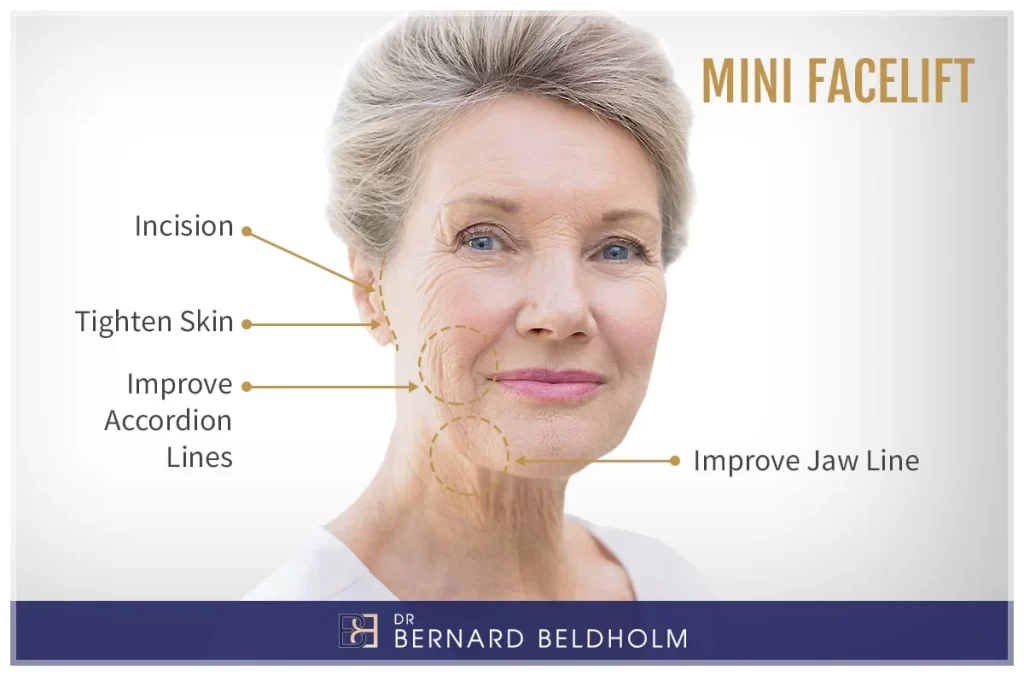
Thread lift and Feather lift
These lifts are performed by using barbed sutures that are pushed through the tissues. There are two types of these sutures available. The permanent sutures and the absorbable sutures. There are a long list of brand names for these sutures. A thread lift, is so called, because a thin needle is used to insert clear polypropylene threads with tiny barbs just under the skin.
- Aptos threads
- Contour threads
- Promoitalia Threads
- ** Soft Face Lift
- Happy Lift™ Revitalizing
- Barbed suture lift
Threads were a trend in the early 2000’s. I personally performed these thread lifts for a period of about two years. However, it was clear to me in that period that there was no benefit to the patient. I had next to no happy patients from all the thread lifts that I had performed, be it with the permanent barbed sutures or the later absorbable sutures.
The premise of these lifts is very appealing; that you could get a facelift result by putting a few threads through the face and suspending the tissues. Unfortunately it does not work. There were so many problems with one of the threads (contour threads), that they were taken off the market in 2008. Few, if any specialist surgeons, would now be performing these thread lifts.
Studies have shown that benefits, if any, are secondary to swelling post procedure, and last as little as 3-6 months.
In one large study the conclusion of the researcher was:
“The thread-lift provides only limited short term ** that may be largely attributed to postprocedural edema and inflammation. Our results objectively demonstrate the poor long-term sustainability of the thread-lift procedure”
They further proceed to state;
“..we cannot justify further use of this procedure for facial rejuvenation…:” (Ref 10)
These findings mirror closely my personal experience with these procedures.
Considering the very long list of problems with these threads:
- Risk of facial nerve damage
- Infection
- Bunching of loose skin
- Thread coming through the skin (extrusion of the thread)
- Visible strings across the face
- Palpable irregularities on the face
If you are considering having a thread lift – don’t. You are exposing yourself to a wide range of potential complications with minimal if any benefit. For select candidates, less-invasive options such as dermal treatments may be a viable alternative.
SMAS lifts
MACS lift (Minimal Access Cranial Suspension lift), the ** lift and plication of the SMAS
These lifts are all about suspending the SMAS in different ways (Ref 9). The skin is lifted off the SMAS. In the MACS lift and the ** lift, a suture is used to lift the SMAS up and attach it to the temporal fascia or cheek bone. The suture is stitched into the SMAS the SMAS is pulled up like a concertina. The excess skin is then resected. The other option is to plicate the SMAS. This means to stitch over the top of the SMAS to tighten it.
These lifts are true SMAS lifts and have been demonstrated to provide good results that are long lasting, (Ref 11)
Two layer facelift
This refers to a facelift where the SMAS is lifted in one direction and the skin is pulled in another direction. When performing a facelift you want to pull the deeper structures straight up to reposition them in a more ** position. The skin is usually pulled backwards to soften up the nasolabial lines and marionette lines. If the skin is pulled in the wrong direction then there may be abnormal wrinkles forming and the facelift might look very unnatural. It is therefore critical to take great care when the skin is closed.
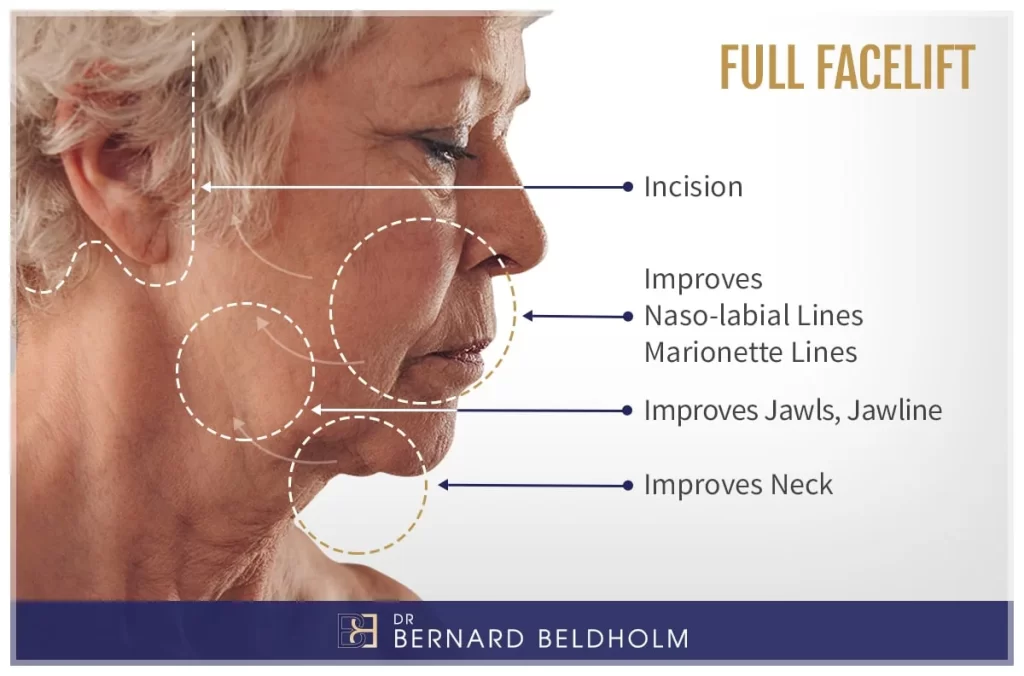
Neck lift, submentoplasty and platysmaplasty
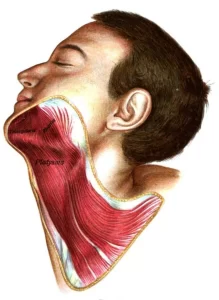
Source: By Dr. Johannes Sobotta – Sobotta’s Atlas and Text-book of Human Anatomy 1909, Public Domain, https://commons.wikimedia.org/w/index.php?curid=29817198
This procedure, also known as a lower rhytidectomy, is commonly performed in conjunction with a facelift. A neck lift ** visible signs of aging along the jawline and neck. It also helps to eliminate loose neck skin, excess fatty deposits under the chin, and excess fat and skin located along the lower face that creates jowls.
The platysma is part of the SMAS muscle. As we age the muscle separates from the underlying structures and starts to **. This causes the characteristic dynamic neck bands in the neck area as we age.
When performing a neck lift, a small incision is made under the chin area, and the platysma muscle is stitched together to tighten the area. The lower part of the platysma muscle is cut to allow it to drape better around the neck area.
The neck lift is usually performed as part of a facelift, as the platysma muscle and skin of the neck need to be stretched laterally to re-drape around the neck. Otherwise there will be loose skin in the neck area.

Facelift (Full), traditional facelift, Extended full facelift or Sub-SMAS facelift
While techniques vary, most of these terms refers to a facelift with full dissection of the skin and working under the SMAS to release and tighten the deeper structures of the face.
Deep plane facelifts
Composite facelift, Deep plane facelift, Endoscopic facelift, Midface lift, Cheek Lift or Subperiosteal Lift
One of the limitations of the SMAS lift is that it does not ** the midface or under the eye area. The deeper facelifts go deep on to the bone, detach facial muscles, and do a lot of work in the under the eye area.
These facelifts were quite popular in the late 1990 and 2000’s as surgeons were looking for better and longer lasting results.
However, research has shown that the more aggressive facelift does not give better results, and do not actually lead to longer lasting results. However, what they do is massively increase the complication rates and recovery from the facelift operation. Because of this most surgeons have moved away from these more severe operations. (Ref 7)
What a facelift will not do
Patients must have realistic expectations. These procedures won’t:
- Change the fundamental appearance of who you are. Dr Beldholm’s goal is to make sure the results of your surgery are “**.” You should look ** and more refreshed. No one should know you’ve had surgery when you go home and have fully healed.
- These surgeries don’t stop the aging process. As long as you’re alive, your body will continue to age. However, that’s a good thing considering the alternative!
- A facelift doesn’t restore volume in the face. This is why Dr Beldholm usually recommends either dermal fillers or fat injections in the areas that have lost volume with age.
- The skin is a very important factor in having a ** look. To achieve the optimal result from your facelift, Dr Beldholm may recommend combine it with other anti-ageing skin treatments.
- Complementary procedures may need to accompany a facelift for patients that desire total facial **. Options may include a brow lift, chin augmentation or eyelid surgery.
You may be wondering, “Which procedure is right for me?” Remember, no two patients are the same. Therefore, no two facelifts are the same. In helping a patient to make decisions about facial rejuvenation, Dr. Beldholm will examine and assess how each aesthetic area of the patient’s face contributes to their overall appearance. An individualised surgical plan is then developed, which ** each patient’s specific concerns and needs.
If you are considering a facelift, consult with specialist general surgeon Dr Bernard Beldholm. He is highly skilled in both surgical and non-surgical facial rejuvenation procedures.
Book your appointment online now
Reference:
- Dane M. Barrett, MDa,*, Deniz Gerecci, MDa , Tom D. Wang, MDb,* “Facelift Controversies”, Facial Plast Surg Clin N Am 24 (2016) 357–36
- Audrey C. Ko, MDa , Bobby S. Korn, MD, PhD, FACSa,b , Don O. Kikkawa, MD, FACSa,b, “The aging face” survey of ophthalmology 62 (2017) 190 e202
- Rohrich RJ; Narasimhan K., “Long-Term Results in Face Lifting: Observational Results and Evolution of Technique.” Plastic & Reconstructive Surgery. 138(1):97-108, 2016 Jul.
- Antell DE; May JM; Bonnano MJ; Lee NY. “A Comparison of the Full and Short-Scar Face-Lift Incision Techniques in Multiple Sets of Identical Twins.” Plastic & Reconstructive Surgery. 137(6):1707-14, 2016 Jun.
- Derby BM; Codner MA. ”Evidence-Based Medicine: Face Lift.” Plastic & Reconstructive Surgery. 139(1):151e-167e, 2017 Jan.
- Wan D; Small KH; Barton FE. “Face Lift.”, Plastic & Reconstructive Surgery. 136(5):676e-89e, 2015 Nov.
- Chang S; Pusic A; Rohrich RJ.. ”A systematic review of comparison of efficacy and complication rates among face-lift techniques. “. Plastic & Reconstructive Surgery. 127(1):423-33, 2011 Jan.
- Skoog T. Plastic surgery: new methods and refinements. Philadelphia: W.B. Saunders; 1974.
- Tonnard P; Verpaele A.”The MACS-lift short scar rhytidectomy.” Aesthetic Surgery Journal. 27(2):188-98, 2007 Mar-Apr.
- Rima F. Abraham, MD; Robert J. DeFatta, MD, PhD; Edwin F. Williams III, MD ”Thread-lift for Facial Rejuvenation. Assessment of Long-term Results” ARCH FACIAL PLAST SURG/ VOL 11 (NO. 3), MAY/JUNE 2009
- https://pubmed.ncbi.nlm.nih.gov/20224461/
Disclaimer:Individual results vary. All surgery carries risks & you should seek a second opinion before proceeding. See full Disclaimer

